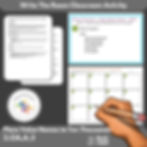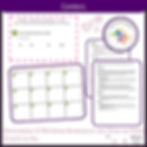Creating individualized education program (IEP) goals can be a tough assignment, especially when it comes to crafting written expression IEP goals that effectively support a student’s development. The key is to focus on the student’s strengths while also targeting areas for improvement. To help you get started, we’ve compiled a list of measurable IEP goals designed to enhance writing skills, oral language comprehension, and written language production.
Why Measurable IEP Goals Matter
IEP goals need to be specific, measurable, and tailored to each student’s needs. For example, if a student struggles with pencil control, it wouldn’t be appropriate to start with a goal like writing the letter “a.” Instead, an initial objective might involve mastering line tracing, building the fine motor skills necessary for writing. Addressing child struggles, particularly in writing and written expression, is crucial for developing measurable IEP goals that focus on skills such as content development, writing fluency, and overall written communication.
This approach ensures that goals are developmentally appropriate and progress logically, laying a solid foundation for more complex skills. However, for new teachers or even experienced educators, drafting these goals can be a daunting process. That’s why resources like TeachTastic IEP are invaluable, offering a growing bank of over 1,000 goals to help guide your efforts.
Sample Measurable IEP Goals for Written Expression
Here are some sample written expression goals to help you create effective, measurable objectives for your students:
Kindergarten Writing IEP Goals
Pencil Control and Tracing
Objective: By (date), the student will improve fine motor skills by tracing lines and shapes with 80% accuracy across 5 trials.
Letter Formation
Objective: By (date), the student will correctly form 10 uppercase letters, improving from 0/10 to 8/10 letters in three consecutive trials.
Sentence Structure
Objective: By (date), the student will write a simple sentence using a capital letter at the beginning and a period at the end, with 80% accuracy across 5 samples.
Objective: By (date), the student will write complete sentences, ensuring proper mechanics such as capitalization and punctuation, with 80% accuracy across 5 samples.
1st Grade Writing IEP Goals
Pencil Grip and Control
Objective: By (date), the student will improve their pencil grip and control, completing tracing activities with 80% accuracy across 5 trials, to support better handwriting skills.
Letter Recognition and Writing
Objective: By (date), the student will correctly identify and write 20 lowercase letters, improving from 5/20 to 18/20 in four consecutive trials.
Simple Sentence Writing
Objective: By (date), the student will write simple sentences using correct word spacing, capitalization, and punctuation, achieving 80% accuracy across 5 writing samples.
Word Spacing
Objective: By (date), the student will demonstrate proper word spacing in writing, with 80% accuracy across 5 written assignments.
Story Sequencing
Objective: By (date), the student will write a three-sentence story, including a beginning, middle, and end, with 80% accuracy in content structure across 5 trials.
Word Choice and Vocabulary
Objective: By (date), the student will use grade-appropriate vocabulary words in writing, demonstrating an improvement from 0/5 to 4/5 in vocabulary usage across 5 samples.
2nd Grade Writing IEP Goals
Capitalization
Objective: By (date), the student will correct capitalization errors in sentences, improving from 0/10 to 8/10 work samples in ten consecutive trials.
Comma Use
Objective: By (date), the student will accurately use commas in a series, dates, and names of places, with 80% accuracy over ten trials.
Combining Sentences
Objective: By (date), the student will combine simple sentences using appropriate conjunctions, demonstrating 80% accuracy over ten trials.
Writing Assignment
Objective: By (date), the student will complete a writing assignment with clear structure, correct mechanics, and relevant content, achieving a score of 80% or higher based on the provided rubric.
3rd Grade Writing IEP Goals
Using Linking Words
Objective: By (date), the student will use linking words (e.g., because, although, since) to connect ideas in a passage, improving accuracy from 0/10 to 8/10 in ten trials.
Transition Words
Objective: By (date), the student will choose the best transition word to complete sentences, achieving 80% accuracy over ten consecutive trials.
Subordinating Conjunctions
Objective: By (date), the student will use subordinating conjunctions to combine two simple sentences, improving writing fluency from 0/10 to 8/10 work samples.
Five Sentence Paragraph
Objective: By (date), the student will write a five sentence paragraph that includes a topic sentence, three supporting details, and a conclusion, achieving 80% accuracy in five trials.
4th Grade Writing IEP Goals
Homophones
Objective: By (date), the student will correctly use commonly confused homophones (e.g., their, there, they’re) in sentences, with 80% accuracy over ten trials.
Identifying Opinions
Objective: By (date), the student will distinguish between fact and opinion in writing prompts, improving from 0/10 to 8/10 in ten consecutive trials.
Organizing Ideas
Objective: By (date), the student will organize information by the main idea, demonstrating 80% accuracy in ten trials.
Writing Assignments
Objective: By (date), the student will complete various writing assignments, such as essays and compositions, to improve overall writing skills, achieving 80% accuracy in structure and grammar over ten trials.
5th Grade Writing IEP Goals
Determining the Main Idea
Objective: By (date), the student will identify the main idea in a passage using key details, improving from 0/10 to 8/10 accuracy over ten trials.
Ordering Sentences
Objective: By (date), the student will arrange sentences in logical order within a paragraph, achieving 80% accuracy in ten trials.
Choosing Topic Sentences
Objective: By (date), the student will select the most appropriate topic sentence for a paragraph, with 80% accuracy over ten trials.
Enhancing Written Expression Skills
Objective: By (date), the student will improve written expression skills by setting realistic and measurable goals, focusing on fine motor skills, planning, and the use of assistive technology, achieving 80% accuracy in ten trials.
Tips for Teachers and Parents
Teacher Tip: When developing IEP goals, consider using a writing rubric to assess and track progress. Regular writing samples across different topics can provide valuable insights into a student’s development.
Teacher Tip: Integrate reading skills into your IEP goals. Emphasize the interconnectedness of reading and writing, as improvements in one area often lead to advancements in the other. This integrated approach can foster better educational outcomes.
Parent Tip: If you’re looking to support your child’s IEP goals at home, review this list with your child’s IEP case manager. It’s a great starting point for understanding the objectives and how you can reinforce them.
Moving Forward
This list of IEP goals is not exhaustive but is intended to help you get started in crafting effective objectives tailored to your students’ needs. While some writing skills, such as developing five-paragraph essays and specific writing assignments, are more complex and require detailed rubrics, they are equally important and will be covered in future articles.
For more sample IEP goals and resources, consider subscribing to our blog. We’re committed to providing tools and strategies that support you in delivering the best education for your students.
































